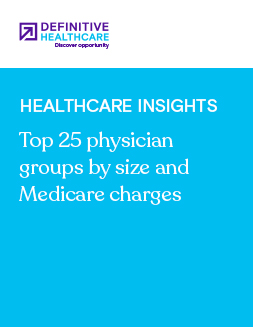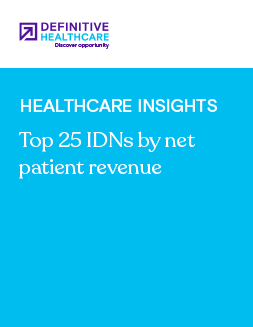Healthcare Insights
Top IDNs by net patient revenue
Net patient revenue (NPR) is a metric used to identify financially successful healthcare organizations. To gain a bigger picture of how financially strong a network of facilities is, the NPR of an integrated delivery network (IDN), or health system, can be a key indicator.
What is an IDN in healthcare?
An integrated delivery network (IDN), also referred to as a health system, is an organization that owns and operates a network of healthcare facilities. An IDN may include facilities such as hospitals, physician groups, clinics, ambulatory surgery centers, and imaging centers, to name a few.
Using the Definitive Healthcare HospitalView product, we have created a list of the top IDNs in the U.S. by their net patient revenue. The data is aggregated from affiliated facilities based on data from the Medicare Cost Report and is according to the most recent 12-month interval tracked in our database.
| Rank | IDN | NPR | HQ city | HQ state | Explore dataset |
|---|---|---|---|---|---|
| 1 | HCA Healthcare | $56.3B | Nashville | TN | Explore |
| 2 | CommonSpirit Health | $29.4B | Chicago | IL | Explore |
| 3 | Kaiser Permanente | $29.1B | Oakland | CA | Explore |
| 4 | Advocate Health | $22.5B | Charlotte | NC | Explore |
| 5 | University of California Health | $21.9B | Oakland | CA | Explore |
| 6 | Providence St Joseph Health | $19.0B | Renton | WA | Explore |
| 7 | Trinity Health | $19.0B | Livonia | MI | Explore |
| 8 | Ascension Health | $16.7B | Saint Louis | MO | Explore |
| 9 | Dignity Health | $16.0B | San Francisco | CA | Explore |
| 10 | AdventHealth | $15.9B | Altamonte Springs | FL | Explore |
Fig. 1 Data is from the Definitive Healthcare HospitalView product. Data is aggregated from affiliated facilities based on data from the Medicare Cost Report and is displayed according to the most recent 12-month interval tracked in our database. Data accessed July 2025.
What is the largest health system in the U.S. by net patient revenue?
The leading IDN in the U.S. by net patient revenue is HCA Healthcare, generating $56.3 billion. This health system is also the largest in the country by the number of member hospitals and staffed beds. With the highest hospital count and bed capacity nationwide, it naturally serves a large patient population, driving its significant net patient revenue.
CommonSpirit Health ranks second, with a net patient revenue of $29.4 billion. Like HCA Healthcare, CommonSpirit is among the largest health systems by member hospitals and staffed beds. It also ranks near the top in terms of affiliated facilities, which helps extend its reach and contribute to its high revenue.
In third place is Kaiser Permanente, with a net patient revenue of $29.1 billion. Like other top IDNs, Kaiser shares characteristics of large health systems, including a significant number of member hospitals and staffed beds, which supports its strong NPR.
What is the average net patient revenue for IDNs?
The average net patient revenue for all IDNs in the U.S. is $1.9 billion. The average NPR for the top 10 IDNs listed above is much greater at $24.6 billion.
Hospital metrics beyond net patient revenue
Net patient revenue (NPR) is a key indicator of an IDN’s financial performance, but it doesn’t tell the whole story. To fully understand the financial health and operational efficiency of a health system, it’s important to consider other metrics related to costs and expenses.
Operating expenses provide critical insight into how much it costs an IDN to deliver care across its network. A high NPR paired with equally high operating expenses could indicate tight profit margins or operational inefficiencies. Conversely, lower operating costs relative to revenue suggest better financial management and resource utilization.
Other important financial metrics to consider include operating margin, average daily census, debt service coverage ratio, supply chain costs, capital investment, bad debt and charity care expenses, and return on assets—each of which provides insight into an IDN’s profitability, financial stability, operational efficiency, and ability to reinvest in growth and quality care.
By examining these financial metrics alongside NPR, healthcare stakeholders can gain a more balanced view of an IDN’s financial stability and capacity for growth. This deeper understanding supports more strategic marketing, partnership decisions, and sales engagements tailored to each health system’s unique financial profile.
Keys to marketing and selling to IDNs
By marketing or selling to a health system offers a strategic opportunity to engage with key decision-makers who influence clinical and operational practices across a wide range of healthcare facilities. Because IDNs manage multiple hospitals, outpatient centers, physician groups, and other care sites, successfully partnering with an IDN can help you reach a larger patient population more efficiently than targeting individual providers or facilities alone.
Engaging IDN leadership requires understanding their priorities, such as improving patient outcomes, reducing costs, and optimizing care coordination. Tailoring your product or therapy messaging to address these goals can increase receptivity and open doors for deeper collaboration.
Moreover, IDNs often have centralized purchasing and standardized protocols, meaning that a single approval can lead to widespread adoption across their network. This scale effect not only accelerates market penetration but also strengthens long-term partnerships, providing sustained growth opportunities.
Finally, demonstrating how your solution integrates with existing workflows and supports value-based care initiatives can further position your offering as an essential tool for IDNs aiming to enhance quality while controlling expenses.
Learn more
Healthcare Insights are developed with healthcare commercial intelligence from the Definitive Healthcare platform. Want even more insights? Start a free trial now and get access to the latest healthcare commercial intelligence on hospitals, physicians, and other healthcare providers.


